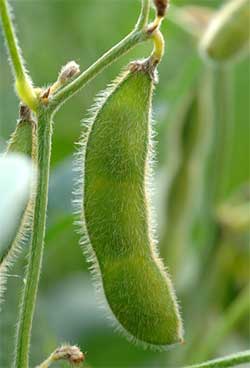Lincoln, Nebraska
September 2, 2005
Source: CropWatch
Another
insecticidal seed treatment for soybeans is now available. Bayer
CropSciences announced registration of Gaucho® seed-applied
insecticide for use against early season insect pests of
soybean. The other currently available seed-applied insecticide
is Cruiser® from Syngenta. Both are neonicitinoid insecticides
-- the active ingredient in Gaucho® is imidicloprid and in
Cruiser®, thiamethoxam.
The question is; “Where do
these insecticidal seed treatments fit in Nebraska soybean
production?” Our major early season soybean insect pest is the
bean leaf beetle. In early spring the over-wintered beetles
become active and often enter soybean fields as soon as plants
emerge. Although the defoliation the beetles cause can appear
quite severe, research in Nebraska and elsewhere has shown that
it usually does not result in economic damage. Soybean plants
can compensate for a large amount of early tissue loss, so it
takes a considerable amount of beetle feeding (generally over
50% defoliation) to impact yield.
|

Coloring of Nebraska's soybean crop had progressed to
15%, ahead of 13% last year but behind 20% average,
according to the USDA Nebraska Agricultural Statistics
Service. One percent of the crop had begun dropping
leaves. |
A possible
exception to this is in very early planted fields, when plants
emerge well before those in surrounding fields. Because the
beetles move to soybean fields during seedling emergence, early
planted fields usually will have more beetles and suffer the
most injury. For those who regularly plant before most of their
neighbors and have a history of high beetle numbers,
insecticidal seed treatments may be an option. Both products,
Cruiser® and Gaucho®, have proved effective against early season
bean leaf beetle in our insecticide trials.
The other soybean insect pest
that some have suggested can be controlled with insecticidal
seed treatments is the soybean aphid. Although early season
aphid mortality and sub-lethal effects have been observed with
insecticidal seed treatments, we do not recommend seed
treatments for controlling soybean aphids in Nebraska.
Dr. David Ragsdale and Brian
McCornack of the University of Minnesota, have conducted soybean
aphid mortality and fecundity (number of offspring) studies to
investigate the questions “How long can we expect systemic
activity of thiamethoxam to last in the soybean plant?” and “How
successful will female soybean aphids be at reproducing on
Cruiser-treated soybean leaves?”
In lab bioassays, they exposed
soybean aphids to soybean leaves pulled from
thiamethoxam-treated plants (50g/100Kg seed) at successively
later intervals after planting. They placed aphids on treated
leaves and recorded percent mortality and the number of
offspring produced per female at 24 hour and 48 hour
exposure/feeding times. Ragsdale and McCornack found that
soybean aphid mortality was significant up to about 35 days
(V3/V4 growth stages), but beyond that point, aphid mortality
decreased toward zero and was no longer significant. They also
found that soybean aphid fecundity was significantly reduced up
to about 40 days after planting. However, beyond 40 days they
saw no difference in the number of nymphs deposited by aphids on
treated and untreated leaves. The Minnesota researchers
concluded that under normal planting dates they did not expect
thiamethoxam seed treatment efficacy to hold, particularly under
high and/or late season soybean aphid pressure.
In a field study, Dr. Michael
Catangui and colleagues from South Dakota State University
examined the effect of insecticidal seed treatments
(thiamethoxam, imidicloprid, and clothianidin, another
neonicitinoid) on soybean aphid populations during R5 soybeans
in August. They found that none of the seed treatments
significantly reduced aphid numbers or increased yield and
concluded that insecticidal sprays would be necessary to control
late season aphid infestations. Their findings are similar to
our trials in Nebraska.
To date in Nebraska, the
soybean aphid has not been an early season pest; it has been a
late season pest. Most of our soybeans are planted in May, and
we generally don’t begin to see aphids until mid to late July,
well past the early vegetative stages. In most fields soybean
aphid populations peak in August. This is too long a period of
time to expect currently available seed treatments to have a
significant effect. In addition, not all soybean fields in
Nebraska will have economic populations of soybean aphids, even
in the northeast part of the state where we have seen the most
soybean aphid injury. This year is a perfect example Why spend
money up front when the need may not arise? With the cost of a
seed treatment at approximately $12-$14 an acre, it is an
expensive “insurance” with a high probability of either not
being needed or not being efficacious when used to manage
soybean aphid. At current prices foliar insecticide treatments
are cheaper than seed treatments and need only be applied when
necessary.
In conclusion, we believe that
insecticidal seed treatments have a role to play in early
planted soybeans for early season bean leaf beetle management,
but we do not recommend insecticidal seed treatments for soybean
aphid management in Nebraska. Manage soybean aphids by scouting
and using economic thresholds. In Nebraska, one well-timed
foliar insecticide application, based on two or more field
visits, will adequately control soybean aphids and protect
yield.
Thomas Hunt
Extension Entomologist
Haskell Ag Lab, Northeast REC
Keith Jarvi
IPM Assistant
Northeast REC |